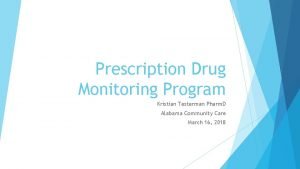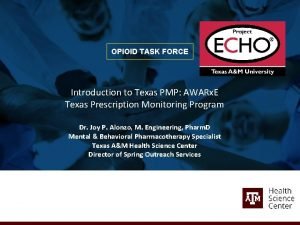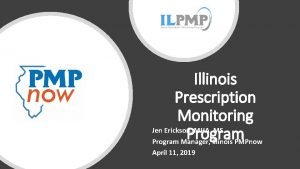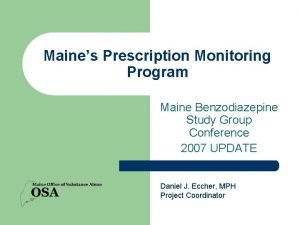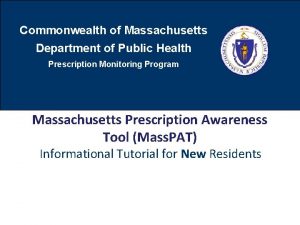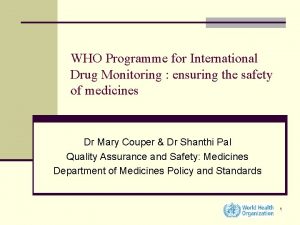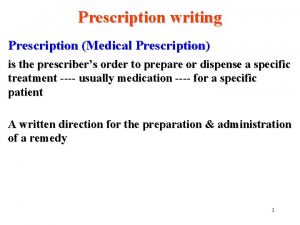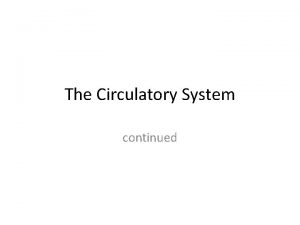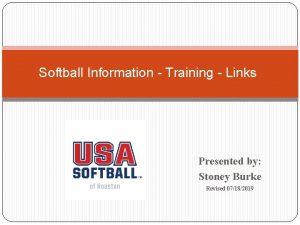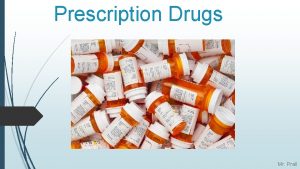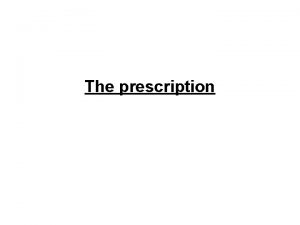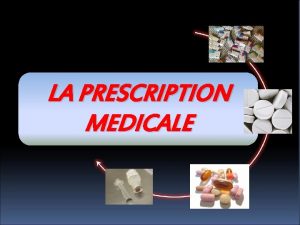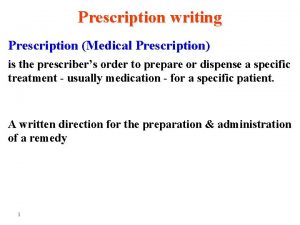Prescription Drug Monitoring Program Kristian Testerman Pharm D











- Slides: 11

Prescription Drug Monitoring Program Kristian Testerman Pharm. D Alabama Community Care March 16, 2018

Prescription Drug Monitoring Program (PDMP) Established and maintained by the Alabama Department of Public Health (ADPH) Purposes: Improve health and welfare Detect diversion, misuse, and abuse of prescription controlled substances Reporting: Became mandatory in April 2006 For anyone who dispenses Controlled Substances Class II-V

Goals of the PDMP Goals: “To provide a source of information for practitioners and pharmacists regarding the controlled substance usage of a patient; To reduce prescription drug abuse by providers and patients; To reduce time and effort to explore leads and assess the merits of possible drug diversion cases; and To educate physicians, pharmacists, policy makers, law enforcement, and the public regarding the diversion, abuse, and misuse of controlled substances. ” Resource: http: //www. alabamapublichealth. gov/PDMP/index. html

PDMP Information The PDMP is NOT linked to insurance companies The PDMP is NOT “real time. ” There is at least a two week lag time from the date of dispensing. If you can’t locate your patient in the PDMP search then please note that the patient may use a different name or different spelling with the dispensing location. The PDMP does not “track” the usage of controlled substances by consumers. It is a database and licensed professionals with access can utilize it for controlled substance history.

PDMP Legal Obligations Please refer to the Code of Alabama (see Title 20, Section 20 -2 -214). "A licensed practitioner approved by the department who has authority to prescribe, dispense, or administer controlled substances, provided, however, that such access shall be limited to information concerning a current or prospective patient of the practitioner. " "Practitioners shall have no requirement or obligation to access or check the information in the controlled substances database prior to prescribing, dispensing, or administering medications or as part of their professional practice. " "A licensed pharmacist approved by the department, provided, however, that such access is limited to information related to the patient or prescribing practitioner designated on a controlled substance prescription that a pharmacist has been asked to fill. Pharmacists shall have no requirement or obligation to access or check the information in the controlled substances database prior to dispensing or administering medications or as part of their professional practices. " Resource: http: //www. alabamapublichealth. gov/PDMP/index. html

Alabama State Board of Medical Examiners (ALBME) Rules and Regulations 540 -X-4 -. 09 Risk and Abuse Mitigation Strategies by Prescribing Physicians Adverse events are more likely to occur at increasing controlled substance pain medication dosages Higher risk for overdose and death The standard for calculating opioid dosages is the Morphine Milligram Equivalency (as set forth by the CDC).

Calculating MME Determine the total daily amount of each opioid that the patient takes Convert the daily amount into MME’s Dose X Conversion Factor= MME Add them together PRECAUTIONS: Conversion Factor Chart: OPIOID (mg/day except where specified) Conversion Factor Codeine 0. 15 Fentanyl transdermal (in mcg/hr) 2. 4 Methadone conversion factor varies Hydrocodone 1 Fentanyl is in mcg/hour NOT mg/day Hydromorphone 4 MME’s are not intended to be utilized for switching between opioids Methadone 1 -20 mg/day 4 Dose conversions are estimates. They do NOT account for variations in individual genetics and pharmacokinetics. 21 -40 mg/day 8 41 -60 mg/day 10 > 61 -80 mg/day 12 Morphine 1 Oxycodone 1. 5 Oxymorphone 3 Resource: https: //www. cdc. gov/drugoverdose/ pdf/calculating_total_daily_dosea. pdf

ALBME Opinion on Risk and Abuse Mitigation Strategies Will vary from patient to patient Examples: “(a) Pill counts; (b) Urine drug screening; (c) PDMP checks; (d) Consideration of abuse-deterrent medications; (e) Monitoring the patient for aberrant behavior; (f) Providing a patient with opiate risk education prior to prescribing controlled substances; and (g) Using validated risk-assessment tools, examples of which shall be maintained by the Board. ” Resource: http: //www. albme. org/riskabusemit. html

ALBME Requirements for Utilizing the PDMP “(a) For controlled substance prescriptions totaling 30 MME or less per day, physicians are expected to use the PDMP in a manner consistent with good clinical practice. (b) When prescribing a patient controlled substances of more than 30 MME per day, physicians shall review that patient's prescribing history through the PDMP at least two (2) times per year, and each physician is responsible for documenting the use of risk and abuse mitigation strategies in the patient’s medical record. (c) Physicians shall query the PDMP to review a patient's prescribing history every time a prescription for more than 90 MME per day is written, on the same day the prescription is written. ” Resource: http: //www. albme. org/riskabusemit. html

ALBME PDMP Exemptions “(a) Nursing home patients; (b) Hospice patients, where the prescription indicates hospice on the physical prescription; (c) When treating a patient for active, malignant pain; or (d) Intra-operative patient care. ” Resource: http: //www. albme. org/riskabusemit. html

ALBME Continued Reconsider benzodiazepine and opioid combination. Consider alternative forms of treatment. Beginning 1/1/2018 each holder of an Alabama Controlled Substance Certificate shall acquire 2 credits of CME in controlled substance prescribing every two years. Physicians are expected to use risk and abuse mitigation strategies when prescribing ANY controlled substance. Physicians should use extreme caution when prescribing multiple controlled substance medications. “A violation of this rule is grounds for the suspension, restriction, or revocation of a physician's Alabama Controlled Substances Certificate or license to practice medicine. ” Resource: http: //www. albme. org/riskabusemit. html
 Alabama prescription drug monitoring program
Alabama prescription drug monitoring program Texas pmp program
Texas pmp program Prescription monitoring program il
Prescription monitoring program il Benzodiazepines
Benzodiazepines Mass prescription monitoring program
Mass prescription monitoring program Who program for international drug monitoring
Who program for international drug monitoring Signatura prescription
Signatura prescription Deliberate adulteration definition
Deliberate adulteration definition Library.med.utah.edu/kw/pharm/hyper heart.html
Library.med.utah.edu/kw/pharm/hyper heart.html Library.med.utah.edu/kw/pharm/hyper heart.html
Library.med.utah.edu/kw/pharm/hyper heart.html Outfield pharm
Outfield pharm Letazol
Letazol
